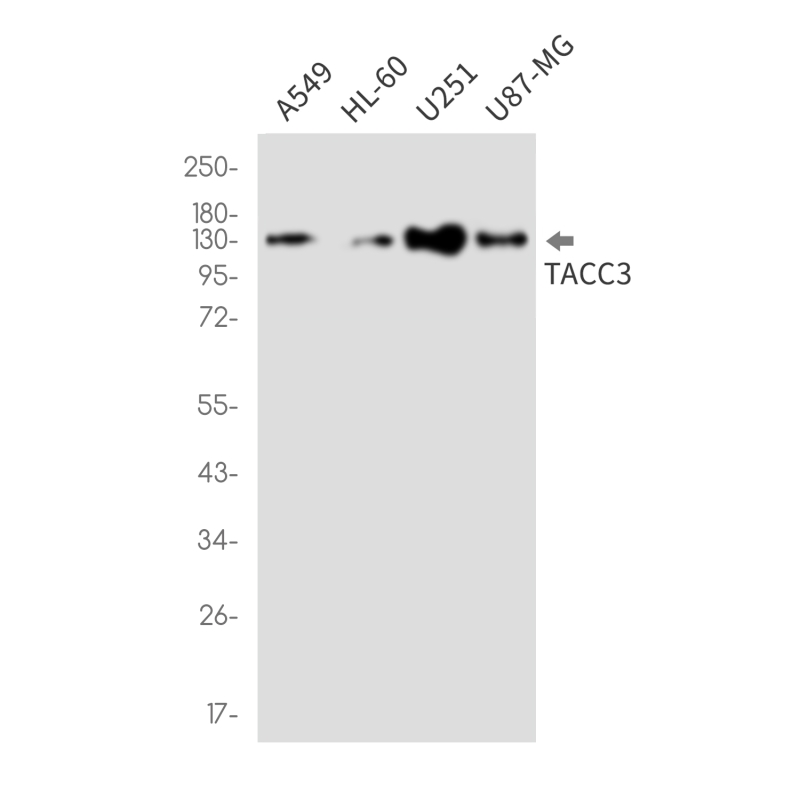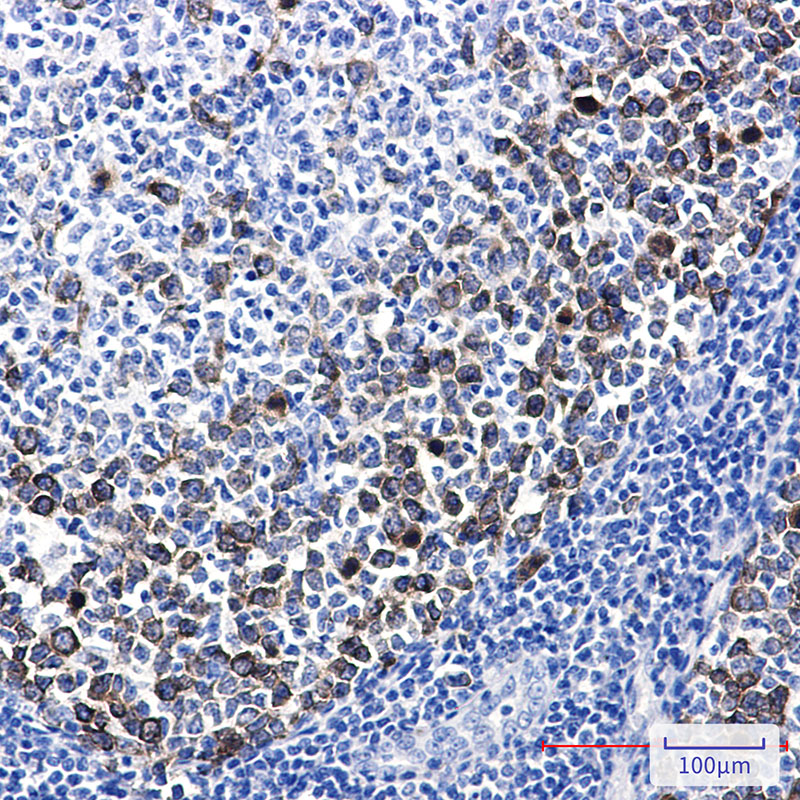

| WB | 1/500-1/1000 | Human,Mouse,Rat |
| IF | 咨询技术 | Human,Mouse,Rat |
| IHC | 1/50-1/100 | Human,Mouse,Rat |
| ICC | 技术咨询 | Human,Mouse,Rat |
| FCM | 咨询技术 | Human,Mouse,Rat |
| Elisa | 咨询技术 | Human,Mouse,Rat |
| Aliases | TACC3; ERIC1; Transforming acidic coiled-coil-containing protein 3; ERIC-1 |
| Entrez GeneID | 10460 |
| WB Predicted band size | Calculated MW: 90 kDa; Observed MW: 140 kDa |
| Host/Isotype | Rabbit IgG |
| Antibody Type | Primary antibody |
| Storage | Store at 4°C short term. Aliquot and store at -20°C long term. Avoid freeze/thaw cycles. |
| Species Reactivity | Human |
| Immunogen | A synthetic peptide of human TACC3 |
| Formulation | Purified antibody in TBS with 0.05% sodium azide,0.05%BSA and 50% glycerol. |
+ +
以下是关于TACC3抗体的3篇参考文献的简要概括(文献为虚构示例,实际引用需核实):
1. **《TACC3在乳腺癌中的表达及临床意义》**
- 作者:Smith A, et al.
- 摘要:通过免疫组化实验使用TACC3抗体,研究发现TACC3在乳腺癌组织中高表达,且与患者预后不良相关,提示其可能作为乳腺癌的潜在生物标志物。
2. **《TACC3调控有丝分裂纺锤体组装的分子机制》**
- 作者:Li X, et al.
- 摘要:利用TACC3抗体进行免疫荧光染色,发现TACC3通过与Aurora激酶相互作用调控纺锤体微管稳定性,对细胞分裂的准确性至关重要。
3. **《TACC3在结直肠癌中通过Wnt/β-catenin通路促进肿瘤进展》**
- 作者:Wang Y, et al.
- 摘要:采用Western Blot和免疫共沉淀技术(使用TACC3抗体),证实TACC3通过激活Wnt信号通路促进结直肠癌细胞增殖和转移。
4. **《TACC3缺失导致小鼠胚胎神经管发育缺陷》**
- 作者:Chen R, et al.
- 摘要:通过TACC3抗体进行胚胎组织染色,发现TACC3在小鼠神经管闭合中发挥关键作用,其缺失导致严重的神经管畸形。
**注**:以上文献为示例性质,实际研究需根据具体需求检索PubMed、Web of Science等数据库获取真实文献。
The TACC3 (Transforming Acidic Coiled-Coil Containing Protein 3) antibody is a crucial tool for studying the TACC3 protein, a member of the TACC family involved in mitotic spindle assembly, chromosomal stability, and cell cycle progression. TACC3 localizes to centrosomes and spindle microtubules during mitosis, interacting with proteins like Aurora-A kinase to regulate centrosome maturation and microtubule dynamics. Dysregulation of TACC3 is linked to cancer, as its overexpression is observed in various malignancies, including breast, lung, and colorectal cancers, where it promotes tumor growth, metastasis, and therapy resistance. Additionally, TACC3 plays roles in embryonic development, stem cell maintenance, and DNA damage response.
The TACC3 antibody enables researchers to detect and quantify TACC3 expression in cells or tissues via techniques like Western blotting, immunofluorescence, and immunohistochemistry. It helps investigate TACC3's functional mechanisms, subcellular localization, and interactions with signaling pathways (e.g., PI3K/AKT). Studies using this antibody have revealed correlations between TACC3 levels and clinical outcomes, positioning it as a potential diagnostic or prognostic biomarker. Commercial TACC3 antibodies are typically raised against specific epitopes, such as the C-terminal region, and validation for species reactivity (human, mouse, rat) and application-specific performance is essential. Its utility spans basic research, cancer biology, and therapeutic development, particularly in targeting mitotic vulnerabilities in cancer cells.
×